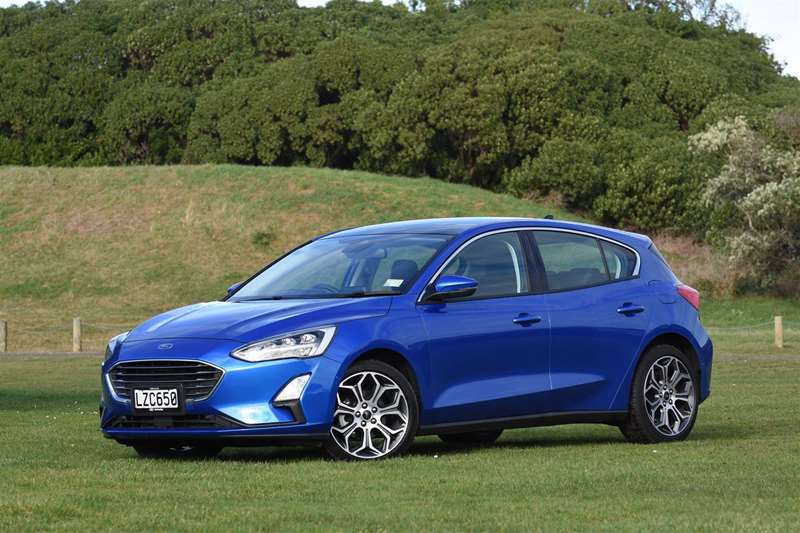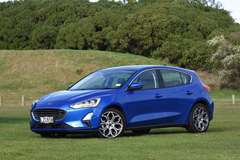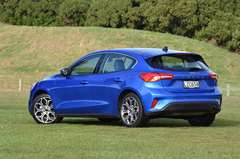The latest Ford Focus has private buyers firmly in sight. David Thomson finds out if he’s a potential target.
What’s new?
This is generation four of the Ford Focus and, after the third generation’s seven-year spell as a global car, its back to a tighter international brief. That brief spans Europe (where the new Focus is designed) and Asia (where it is also being built), inclusive of the wider Pacific, of which we are a part.
Ford’s soon to be widely used C2 platform makes its debut with this Focus. It brings a 53mm increase in wheelbase, greater structural rigidity, improved crash protection, more interior space and a weight saving of almost 90kg.
There are the new mechanicals too: a 134kW/240Nm 1.5-litre three-cylinder turbo-petrol engine in place of a four-cylinder unit of identical capacity and very similar outputs; and a new eight-stage continuously variable transmission to deliver power to the front wheels.
Plus the latest in hi-tech cleverness, encompassing a raft of new or updated driver and active safety aids, new technology to improve handling, and improved multimedia interfaces.
This road test involved the $41,990 Titanium Hatch, which is, for now at least, the flagship of the range. That range also features the Trend ($31,990) and ST-Line ($36,990) hatchbacks deploying the same drivetrain as the Titanium, as well as the fleet-focused $37,990 turbo-diesel Trend wagon.
What comes as standard?
Within the range, the Trend hatch comes with dual-zone climate control, cruise control, and an eight-inch dash-mounted touchscreen with satellite navigation, seamless Bluetooth connectivity, Apple CarPlay and Android Auto integration, and a six-speaker sound system. Its safety package includes autonomous emergency braking (AEB), with night-time pedestrian detection and cyclist detection, lane departure warning and lane-keep assist, a 180-degree rear-view camera and rear parking sensors.
The ST-Line and Titanium add keyless entry and start, auto lights, rain-sensing wipers and heated mirrors into the mix along with a substantially enhanced safety package. This provides adaptive radar cruise control, active lane-keeping assistance, evasive steering assistance, blind-spot monitoring, and rear cross-traffic alert.
While the ST-Line features sporting garnishes, the Titanium loads up with comfort and convenience features. These include a head-up display, fully-automated self-parking, a panorama sunroof, self-levelling LED headlights, multicolour LED interior lighting, heated front seats (the driver’s is also power-adjusting) and premium trim.
What’s it like to look at?
A strong continuity of look between generations is apparent with the new Focus, helped to an extent by it being only fractionally longer and minimally wider than the model it replaces.
That said, this latest Focus sits a little squatter on the road, due in equal measure to that increased wheelbase and a 30mm reduction in height. A slightly longer bonnet and A-pillars positioned further back than before alter the car’s proportions, as do shorter overhangs.
While the ST-Line takes the most bling, the Titanium still exudes plenty of visual presence, helped by its 18-inch alloys and 205/40 tyres. LED lights, and rear spoiler.
What’s it like inside?
Starting from the back and working forward, a 375-litre boot capacity is a big improvement on the old model’s 316-litre hold, and shifts the Focus to the upper-middle of its class for luggage space. Split 60:40, the rear seat back includes a load-through ski-flap, and the seat backs can be folded forward to boost carrying capacity. Two niggles are a high load-lip for the boot, and seat backs that create a stepped rather than flat extended floor area.
The Titanium’s full-length panorama sunroof gives a light airy feel to the rear of the cabin. Access to the back seats is excellent, and although slightly knees up, the rear seating position rates well for both leg and head room. The fold-down centre armrest includes twin cup holders, but there are no separate air vents or USB plug points for rear-seat occupants.
A very clean-lined and angular dash dominates the front of the cabin. Topped by the eight-inch centre touchscreen, it features soft-touch upper surfaces and classy brushed-metal highlighting. There’s plenty of soft-touch surfacing below the cabin waistline too, though some of it feels light and flimsy. The centre console is fitted with a lidded centre bin/arm rest, a shallow tray just forward of it, twin cupholders and a further tray at the base of the dashboard. Providing two USB plugs, only one of them chargeable, is bare minimum in the modern age.
Trimmed in a mix of artificial leather and cloth, the power-operated driver’s seat is comfortable and supportive. The driving position and instrumentation is very good too, and the new SYNC3 multimedia interface and centre touchscreen rates highly for clarity and ease of use.
Ford’s boldest call in respect of controls has been to replace the conventional gear lever with a rotary knob. It’s similar in function to that deployed on the Ford Endura; rotate right to progress through park, reverse, neutral and drive; tap a button on top to access manual mode, which is operated in conjunction with paddle-shifts on the steering wheel.
A further button aft of the rotary knob allows the driver to switch between eco, normal and sport modes — like the start button tucked away behind the steering wheel, this button could be better positioned.
What’s it like to drive?
The first and second generations of the Focus scored highly for driver appeal. The third generation version less so, largely because its global brief meant appealing to the North American as well as European and Asian markets. This time round, there’s a move back towards a handling dynamic that will put a smile on the face of the enthusiast.
Guided over winding backroads, the test car impressed for its ability to corner flat, with great balance and composure. Steering is accurate and well-weighted if a little lacking in feel. The brakes are sharp, too. Some credit for the test car’s surefootedness in damp and slippery conditions also goes to its torque vectoring control system. This system deploys subtle braking to the inside front wheel during tight cornering to increase torque delivery to the outside front wheel, thus improving traction and handling.
The balance between sharp handling and decently absorbent ride was well struck by the test car. This feature was particularly noticeable as the Focus was assessed immediately after a similar-sized and much more upmarket European rival, and outdid this fancied vehicle for handling prowess and, even more clearly, ride comfort.
While appreciated on backroads, good-quality ride is an even more important consideration for highway and around-town motoring.
The test car’s strengths were further aided by its adaptive radar cruise control, and a lane-keeping assist system that is less obtrusive than some equivalent systems I have tried.
A neat trick too, for a vehicle that is also an easy around-town steer, is its self-parking system. Ford has been including such systems on its small cars for a few years now; the version fitted to the Titanium edition of the Focus is the latest Active Park Assist 2. Activated at the push of a button, it will firstly identify a viable parking space and instruct the driver to stop. Previously the car would then steer itself into the park while the driver operated the accelerator pedal. Now, you simply rotate the gear knob to neutral, push a button, and sit while the car completes the process on its own.
Last and not least, the new Focus’s driving experience involves the distinctive character of its engine. Like others of this increasingly common three-cylinder in-line ilk, the engine has a distinctive and slightly discordant growl that can become raucous when revved hard.
But if you are expecting such an engine to be low on puff, think again. Mustering 240Nm of peak torque from just 1600rpm, it works its way up the rev range deftly after a hint of lag on initial throttle application. The motor works very smoothly with an eight-stage CVT gearbox that is one of the best I have sampled for both smoothness, and its ability to mimic a conventional automatic with clearly defined shift points.
In sport mode, a dash from 0-100kmh takes a shade over nine seconds. I couldn’t quite equal the standard cycle economy figure of 6.4 litres per 100km on test, but managed close to that on an extended highway haul, and an overall return of 7.5l/100km in mix of conditions.
Verdict
Our motoring market may appear to be SUV-mad, but the latest Focus provides a timely reminder of just how accomplished a compact hatchback can be. Appreciably better than its predecessor, it’s also up there with the very best in its class.
Photos: David Thomson










